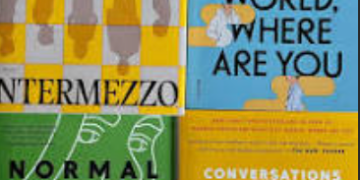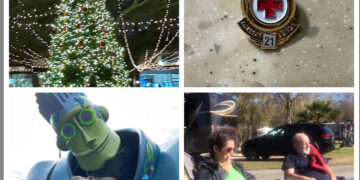
In January of 2020 at WBTX, the Sunday afternoon 1:00-2:00pm slot became available for a new program. In March, In Concert debuted. This show would present a southern gospel ‘live’ concert album, “the way it was meant to be enjoyed: in full – from the introduction through that final encore.”
This January, In Concert begins its third season, and as we approach the 100th episode, I still have not had to repeat an album – there are so many to choose from. And the history of these albums is quite interesting. Let’s take a brief look at how they came about, the ‘golden era’ of the live album, and their eventual downfall…
The concept of a live concert album is simple, and applicable for all styles of music – make a recording of the artist performing a concert, and try to capture the excitement of the live setting. Simple enough? Well, when the first southern gospel ‘live’ albums came about, they were not what you might have expected….
In July of 1959, the Blackwood Brothers recorded one of their appearances in Los Angeles, California. In 1960, this recording was issued on the RCA Victor label as The Blackwood Brothers In Concert. If one listens to the album, there is practically only one difference between this and a ‘studio’ album – applause – and just applause. There is no introduction of the group, no talk from the emcee (James Blackwood) nor amongst the group members. It’s just the songs and applause – a heavily edited program. (Reportedly, thirty songs were recorded, twelve made the album). Granted, the concept was new, and would need some fine tuning the years went on.
The amount of editing was reduced as the 1960s progressed. The Blackwood’s 1963 release, On Stage, has more of your typical ‘live’ concert elements – an introduction, James Blackwood emceeing between songs, and even a bit of humor. James Blackwood reads an ‘audience’ request: ‘Would you please feature your bass singer, J.D. Sumner, singing some real low bass…signed, J.D. Sumner.’
The ‘game changer’ would come 1973 from a relatively new group at the time – the Kingsmen from Asheville, North Carolina. The album, their first on Canaan Records, was Big & Live, recorded in Gadsden, Alabama. With Jim Hamill as emcee, the Kingsmen presented such up-tempo numbers as “Ready To Leave”, “So High”, and “When I Wake Up To Sleep No More” (with three encores), as well as some down-tempo: “Love Lifted Me” and “The Apple Tree Story”. Truly ‘raw’ in nature – plenty of applause, shouting, amens…
…and that’s when the executives at Canaan Records had a problem. According to the Kingsmen’s longtime manager, Eldrige Fox, the folks at Canaan were unsure about releasing such a ‘raw’ recording. They wanted to ‘play it safe’ and ‘polish’ it. The Kingsmen’s response – either release the album ‘as is’, with the “amens and hallelujahs”, or they would leave Canaan. The Kingsmen won, and the Dove-award-winning Big & Live remains one of the most popular southern gospel live albums to date.
Earning them the nickname the ‘ton of fun’ the Kingsmen would continue to record live projects of the same caliber. In the 1980s alone, they would produce six live recordings. Other groups would use the format more sparingly. For instance, in the 1980s, fans of the Cathedrals would see only one live release – Live In Atlanta.
By the early 1990s, with the advent of CDs, many groups gravitated towards a live album, as there was no longer such a time constraint (for an LP, it was 45-50 minutes maximum – CD up to 65-70 minutes). Secondly, groups could also videotape the concert, and therefore make the live album available not just on CD, but also VHS. One group that would dominate the ‘live’ setting during this era was the McGruders. This trio included noted songwriter Carroll McGruder, his wife Priscilla, and Stan Cook. Their 1990 album/video release Come Fly with the McGruders (and 1991 follow-up In Motion) are perhaps the most high-energy southern gospel live albums to date. Very few songs get by without an encore…or three. As Ronny Hinson introduced the McGruders on the former, “our engines are warmed up, Captain Jesus is at the controls, and the tower has cleared us for take-off…if you’re afraid of heights, you better bail out now!”. (If you want a blessing, search online for ‘McGruders In Motion’).
Then, as the 2000s progressed, the number of live albums being produced decreased dramatically. Those that were issued followed the early-1960s style of being heavily edited, with little to no talk between the songs. So what led to the demise of the live album? There’s no definitive answer, but here’s my take: As the 2000s played out, fewer groups were using a live band. Remember, in the olden days, practically every group had a three-to-five piece band. Largely due to financial reasons, many groups nowadays utilize soundtracks. Therefore, a ‘live’ concert album might not sound all that different from a ‘studio’ album, save for applause and the emcee work (which, granted, can make an exceptional live album, and there have been some great ones within the last 20 years, namely Legacy Five’s Live In Music City). Also, with the advent of video sharing sites (such as YouTube), one can watch a ‘live’ performance on-demand and free of charge.
While they’re not as commonplace nowadays, the southern gospel live album has certainly played a key role in shaping this great music. And remember, you can enjoy one of these live albums each week on WBTX. Tune in to “In Concert”, Sunday afternoons at 1:00pm!
































